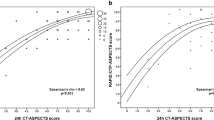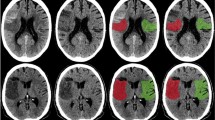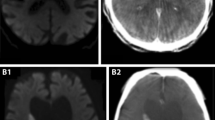Abstract
Introduction
Although the diagnostic performance of whole-brain computed tomographic perfusion (WB-CTP) in the detection of supratentorial infarctions is well established, its value in the detection of infratentorial strokes remains less well defined. We examined its diagnostic accuracy in the detection of infratentorial infarctions and compared it to nonenhanced computed tomography (NECT), aiming to identify factors influencing its detection rate.
Methods
Out of a cohort of 1380 patients who underwent WB-CTP due to suspected stroke, we retrospectively included all patients with MRI-confirmed infratentorial strokes and compared it to control patients without infratentorial strokes. Two blinded readers evaluated NECT and four different CTP maps independently for the presence and location of infratentorial ischemic perfusion deficits.
Results
The study was designed as a retrospective case-control study and included 280 patients (cases/controls = 1/3). WB-CTP revealed a greater diagnostic sensitivity than NECT (41.4 vs. 17.1 %, P = 0.003). The specificity, however, was comparable (93.3 vs. 95.0 %). Mean transit time (MTT) and time to drain (TTD) were the most sensitive (41.4 and 40.0 %) and cerebral blood volume (CBV) the most specific (99.5 %) perfusion maps. Infarctions detected using WB-CTP were significantly larger than those not detected (15.0 vs. 2.2 ml; P = 0.0007); infarct location, however, did not influence the detection rate.
Conclusion
The detection of infratentorial infarctions can be improved by assessing WB-CTP as part of the multimodal stroke workup. However, it remains a diagnostic challenge, especially small volume infarctions in the brainstem are likely to be missed.


Similar content being viewed by others
Abbreviations
- WB-CTP:
-
Whole-brain computed tomgraphic perfusion
- MTT:
-
Mean transit time
- TTD:
-
Time to drain
- CBV:
-
Cerebral blood volume
- CBF:
-
Cerebral blood flow
- NECT:
-
Nonenhanced CT
- CTA:
-
CT angiography
References
Bogousslavsky J, Van Melle G, Regli F (1988) The Lausanne Stroke Registry: analysis of 1,000 consecutive patients with first stroke. Stroke 19(9):1083–1092
Flossmann E, Redgrave JN, Briley D, Rothwell PM (2008) Reliability of clinical diagnosis of the symptomatic vascular territory in patients with recent transient ischemic attack or minor stroke. Stroke 39(9):2457–2460. doi:10.1161/STROKEAHA.107.511428
Tao WD, Liu M, Fisher M, Wang DR, Li J, Furie KL, Hao ZL, Lin S, Zhang CF, Zeng QT, Wu B (2012) Posterior versus anterior circulation infarction: how different are the neurological deficits? Stroke 43(8):2060–2065. doi:10.1161/STROKEAHA.112.652420
Kuruvilla A, Bhattacharya P, Rajamani K, Chaturvedi S (2011) Factors associated with misdiagnosis of acute stroke in young adults. J Stroke Cerebrovasc Dis 20(6):523–527. doi:10.1016/j.jstrokecerebrovasdis.2010.03.005
Muir KW, Buchan A, von Kummer R, Rother J, Baron JC (2006) Imaging of acute stroke. Lancet Neurol 5(9):755–768. doi:10.1016/S1474-4422(06)70545-2
Thierfelder KM, Sommer WH, Baumann AB, Klotz E, Meinel FG, Strobl FF, Nikolaou K, Reiser MF, von Baumgarten L (2013) Whole-brain CT perfusion: reliability and reproducibility of volumetric perfusion deficit assessment in patients with acute ischemic stroke. Neuroradiology 55(7):827–835. doi:10.1007/s00234-013-1179-0
Lin K, Do KG, Ong P, Shapiro M, Babb JS, Siller KA, Pramanik BK (2009) Perfusion CT improves diagnostic accuracy for hyperacute ischemic stroke in the 3-hour window: study of 100 patients with diffusion MRI confirmation. Cerebrovasc Dis 28(1):72–79. doi:10.1159/000219300
Bivard A, Spratt N, Levi C, Parsons M (2011) Perfusion computer tomography: imaging and clinical validation in acute ischaemic stroke. Brain 134(Pt 11):3408–3416. doi:10.1093/brain/awr257
Wintermark M, Flanders AE, Velthuis B, Meuli R, van Leeuwen M, Goldsher D, Pineda C, Serena J, van der Schaaf I, Waaijer A, Anderson J, Nesbit G, Gabriely I, Medina V, Quiles A, Pohlman S, Quist M, Schnyder P, Bogousslavsky J, Dillon WP, Pedraza S (2006) Perfusion-CT assessment of infarct core and penumbra: receiver operating characteristic curve analysis in 130 patients suspected of acute hemispheric stroke. Stroke 37(4):979–985. doi:10.1161/01.STR.0000209238.61459.39
Nabavi DG, Cenic A, Henderson S, Gelb AW, Lee TY (2001) Perfusion mapping using computed tomography allows accurate prediction of cerebral infarction in experimental brain ischemia. Stroke 32(1):175–183
Wintermark M, Reichhart M, Cuisenaire O, Maeder P, Thiran JP, Schnyder P, Bogousslavsky J, Meuli R (2002) Comparison of admission perfusion computed tomography and qualitative diffusion- and perfusion-weighted magnetic resonance imaging in acute stroke patients. Stroke 33(8):2025–2031
Schaefer PW, Barak ER, Kamalian S, Gharai LR, Schwamm L, Gonzalez RG, Lev MH (2008) Quantitative assessment of core/penumbra mismatch in acute stroke: CT and MR perfusion imaging are strongly correlated when sufficient brain volume is imaged. Stroke 39(11):2986–2992. doi:10.1161/STROKEAHA.107.513358
Parsons MW (2008) Perfusion CT: is it clinically useful? Int J Stroke 3(1):41–50. doi:10.1111/j.1747-4949.2008.00175.x
Morhard D, Wirth CD, Fesl G, Schmidt C, Reiser MF, Becker CR, Ertl-Wagner B (2010) Advantages of extended brain perfusion computed tomography: 9.6 cm coverage with time resolved computed tomography-angiography in comparison to standard stroke-computed tomography. Investig Radiol 45(7):363–369. doi:10.1097/RLI.0b013e3181e1956f
Best AC, Acosta NR, Fraser JE, Borges MT, Brega KE, Anderson T, Neumann RT, Ree A, Bert RJ (2012) Recognizing false ischemic penumbras in CT brain perfusion studies. Radiographics 32(4):1179–1196. doi:10.1148/rg.324105742
Thierfelder KM, Baumann AB, Sommer WH, Armbruster M, Opherk C, Janssen H, Reiser MF, Straube A, von Baumgarten L (2014) Vertebral artery hypoplasia: frequency and effect on cerebellar blood flow characteristics. Stroke 45(5):1363–1368. doi:10.1161/STROKEAHA.113.004188
Rothman KJ (2012) Epidemiology: an introduction, second edn. Oxford University Press, New York; Oxford
Ury HK (1975) Efficiency of case-control studies with multiple controls per case: continuous or dichotomous data. Biometrics 31(3):643–649
Miettinen OS (1969) Individual matching with multiple controls in the case of all-or-none responses. Biometrics 25(2):339–355
Biesbroek JM, Niesten JM, Dankbaar JW, Biessels GJ, Velthuis BK, Reitsma JB, van der Schaaf IC (2013) Diagnostic accuracy of CT perfusion imaging for detecting acute ischemic stroke: a systematic review and meta-analysis. Cerebrovasc Dis 35(6):493–501. doi:10.1159/000350200
Hana T, Iwama J, Yokosako S, Yoshimura C, Arai N, Kuroi Y, Koseki H, Akiyama M, Hirota K, Ohbuchi H, Hagiwara S, Tani S, Sasahara A, Kasuya H (2014) Sensitivity of CT perfusion for the diagnosis of cerebral infarction. J Med Investig 61(1–2):41–45
Campbell BC, Weir L, Desmond PM, Tu HT, Hand PJ, Yan B, Donnan GA, Parsons MW, Davis SM (2013) CT perfusion improves diagnostic accuracy and confidence in acute ischaemic stroke. J Neurol Neurosurg Psychiatry 84(6):613–618. doi:10.1136/jnnp-2012-303752
Lin K, Do KG, Ong P, Shapiro M, Babb JS, Siller KA, Pramanik BK (2009) Perfusion CT improves diagnostic accuracy for hyperacute ischemic stroke in the 3-h window: study of 100 patients with diffusion MRI confirmation. Cerebrovasc Dis 28(1):72–79. doi:10.1159/000219300
Thierfelder KM, von Baumgarten L, Lochelt AC, Meinel FG, Armbruster M, Beyer SE, Patzig M, Opherk C, Reiser MF, Sommer WH (2014) Diagnostic accuracy of whole-brain computed tomographic perfusion imaging in small-volume infarctions. Investig Radiol 49(4):236–242. doi:10.1097/RLI.0000000000000023
Rudilosso S, Urra X, San Roman L, Laredo C, Lopez-Rueda A, Amaro S, Oleaga L, Chamorro A (2015) Perfusion deficits and mismatch in patients with acute lacunar infarcts studied with whole-brain CT perfusion. AJNR Am J Neuroradiol 36(8):1407–1412. doi:10.3174/ajnr.A4303
Lee IH, You JH, Lee JY, Whang K, Kim MS, Kim YJ, Lee MS, Brain Research G (2010) Accuracy of the detection of infratentorial stroke lesions using perfusion CT: an experimenter-blinded study. Neuroradiology 52(12):1095–1100. doi:10.1007/s00234-010-0689-2
van der Hoeven EJ, Dankbaar JW, Algra A, Vos JA, Niesten JM, van Seeters T, van der Schaaf IC, Schonewille WJ, Kappelle LJ, Velthuis BK, Investigators D (2015) Additional diagnostic value of computed tomography perfusion for detection of acute ischemic stroke in the posterior circulation. Stroke 46(4):1113–1115. doi:10.1161/STROKEAHA.115.008718
Pallesen LP, Gerber J, Dzialowski I, van der Hoeven EJ, Michel P, Pfefferkorn T, Ozdoba C, Kappelle LJ, Wiedemann B, Khomenko A, Algra A, Hill MD, von Kummer R, Demchuk AM, Schonewille WJ, Puetz V (2015) Diagnostic and prognostic impact of pc-ASPECTS applied to perfusion CT in the basilar artery international cooperation study. Journal of neuroimaging : official journal of the American Society of Neuroimaging 25(3):384–389. doi:10.1111/jon.12130
Wintermark M, Fischbein NJ, Smith WS, Ko NU, Quist M, Dillon WP (2005) Accuracy of dynamic perfusion CT with deconvolution in detecting acute hemispheric stroke. AJNR Am J Neuroradiol 26(1):104–112
Sabarudin A, Subramaniam C, Sun Z (2014) Cerebral CT angiography and CT perfusion in acute stroke detection: a systematic review of diagnostic value. Quantitative imaging in medicine and surgery 4(4):282–290. doi:10.3978/j.issn.2223-4292.2014.07.10
Chalela JA, Kidwell CS, Nentwich LM, Luby M, Butman JA, Demchuk AM, Hill MD, Patronas N, Latour L, Warach S (2007) Magnetic resonance imaging and computed tomography in emergency assessment of patients with suspected acute stroke: a prospective comparison. Lancet 369(9558):293–298. doi:10.1016/S0140-6736(07)60151-2
Edlow JA, Newman-Toker DE, Savitz SI (2008) Diagnosis and initial management of cerebellar infarction. Lancet Neurol 7(10):951–964. doi:10.1016/S1474-4422(08)70216-3
von Kummer R, Bourquain H, Bastianello S, Bozzao L, Manelfe C, Meier D, Hacke W (2001) Early prediction of irreversible brain damage after ischemic stroke at CT. Radiology 219(1):95–100. doi:10.1148/radiology.219.1.r01ap0695
von Kummer R, Nolte PN, Schnittger H, Thron A, Ringelstein EB (1996) Detectability of cerebral hemisphere ischaemic infarcts by CT within 6 h of stroke. Neuroradiology 38(1):31–33
Grotta JC, Chiu D, Lu M, Patel S, Levine SR, Tilley BC, Brott TG, Haley EC Jr, Lyden PD, Kothari R, Frankel M, Lewandowski CA, Libman R, Kwiatkowski T, Broderick JP, Marler JR, Corrigan J, Huff S, Mitsias P, Talati S, Tanne D (1999) Agreement and variability in the interpretation of early CT changes in stroke patients qualifying for intravenous rtPA therapy. Stroke 30(8):1528–1533
Wardlaw JM, Farrall AJ, Perry D, von Kummer R, Mielke O, Moulin T, Ciccone A, Hill M (2007) Factors influencing the detection of early CT signs of cerebral ischemia: an internet-based, international multiobserver study. Stroke 38(4):1250–1256. doi:10.1161/01.STR.0000259715.53166.25
Author information
Authors and Affiliations
Corresponding author
Ethics declarations
We declare that all human studies have been approved by the institutional ethics committee of the Medical Faculty of the Ludwig-Maximilians University Munich and have therefore been performed in accordance with the ethical standards laid down in the 1964 Declaration of Helsinki and its later amendments. We declare that the ethics committee waived informed patient consent.
Conflict of interest
We declare that we have no conflict of interest.
Additional information
CB and AP contributed equally to this work.
Rights and permissions
About this article
Cite this article
Bollwein, C., Plate, A., Sommer, W.H. et al. Diagnostic accuracy of whole-brain CT perfusion in the detection of acute infratentorial infarctions. Neuroradiology 58, 1077–1085 (2016). https://doi.org/10.1007/s00234-016-1743-5
Received:
Accepted:
Published:
Issue Date:
DOI: https://doi.org/10.1007/s00234-016-1743-5




